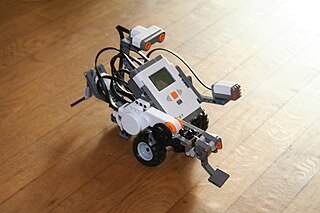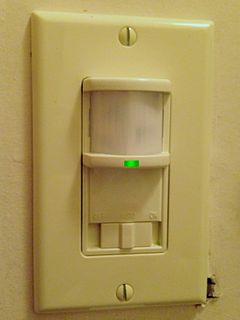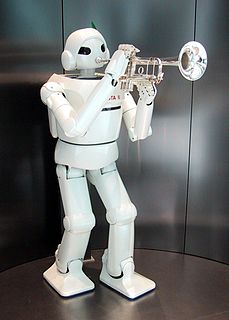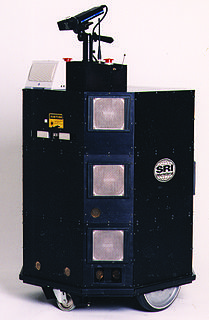Related Research Articles
An autonomous robot is a robot that acts without recourse to human control. The first autonomous robots environment were known as Elmer and Elsie, which were constructed in the late 1940s by W. Grey Walter. They were the first robots in history that were programmed to "think" the way biological brains do and meant to have free will. Elmer and Elsie were often labeled as tortoises because of how they were shaped and the manner in which they moved. They were capable of phototaxis which is the movement that occurs in response to light stimulus.

Roomba is a series of autonomous robotic vacuum cleaners sold by iRobot. Introduced in September 2002, they have a set of sensors that enable them to navigate the floor area of a home. These sensors can detect the presence of obstacles, particularly dirty spots on the floor, and steep drops.

An autonomous underwater vehicle (AUV) is a robot that travels underwater without requiring input from an operator. AUVs constitute part of a larger group of undersea systems known as unmanned underwater vehicles, a classification that includes non-autonomous remotely operated underwater vehicles (ROVs) – controlled and powered from the surface by an operator/pilot via an umbilical or using remote control. In military applications an AUV is more often referred to as an unmanned undersea vehicle (UUV). Underwater gliders are a subclass of AUVs.

An electronic component is any basic discrete device or physical entity in an electronic system used to affect electrons or their associated fields. Electronic components are mostly industrial products, available in a singular form and are not to be confused with electrical elements, which are conceptual abstractions representing idealized electronic components and elements.

The Johns Hopkins University Applied Physics Laboratory is a not-for-profit university-affiliated research center (UARC) in Howard County, Maryland. It is affiliated with Johns Hopkins University and employs 7,200 people (2020). The lab serves as a technical resource for the Department of Defense, NASA, and other government agencies. APL has developed numerous systems and technologies in the areas of air and missile defense, surface and undersea naval warfare, computer security, and space science and spacecraft construction. While APL provides research and engineering services to the government, it is not a traditional defense contractor, as it is a UARC and a division of Johns Hopkins University. APL is a scientific and engineering research and development division, rather than an academic division, of Johns Hopkins.

The Electrolux Trilobite is a robotic vacuum cleaner manufactured by the Swedish corporation Electrolux. It takes its name from the extinct arthropod, which scoured the ocean's floor. The prototype cleaner was first seen on the BBC television programme, Tomorrow's World, in May 1996, when it was demonstrated by presenter Philippa Forrester. It was the world's first commercially available autonomous vacuum cleaner, introduced as a product in 2001, model ZA1. A revision was released as Version 2.0 in 2004, model ZA2.

A mobile robot, is a robot that is capable of moving in the surrounding (locomotion). Mobile robotics is usually considered to be a subfield of robotics and information engineering.

Acoustic location is the use of sound to determine the distance and direction of its source or reflector. Location can be done actively or passively, and can take place in gases, liquids, and in solids.

The Mark 37 torpedo is a torpedo with electrical propulsion, developed for the US Navy after World War II. It entered service with the US Navy in the early 1950s, with over 3,300 produced. It was phased out of service with the US Navy during the 1970s, and the stockpiles were sold to foreign navies.

Lego Mindstorms NXT is a programmable robotics kit released by Lego in late July 2006. It replaced the first-generation Lego Mindstorms kit, which was called the Robotics Invention System. The base kit ships in two versions: the Retail Version and the Education Base Set. It comes with the NXT-G programming software, or optionally LabVIEW for Lego Mindstorms. A variety of unofficial languages exist, such as NXC, NBC, leJOS NXJ, and RobotC. The second generation of the set, the Lego Mindstorms NXT 2.0, was released on August 1, 2009, featuring a color sensor and other upgraded capabilities. The third generation, the EV3, was released in September 2013.
Robotics is the branch of technology that deals with the design, construction, operation, structural disposition, manufacture and application of robots. Robotics is related to the sciences of electronics, engineering, mechanics, and software. The word "robot" was introduced to the public by Czech writer Karel Čapek in his play R.U.R., published in 1920. The term "robotics" was coined by Isaac Asimov in his 1941 science fiction short-story "Liar!"

An occupancy sensor is an indoor motion detecting device used to detect the presence of a person to automatically control lights or temperature or ventilation systems. The sensors use infrared, ultrasonic, microwave, or other technology. The term encompasses devices as different as PIR sensors, hotel room keycard locks and smart meters. Occupancy sensors are typically used to save energy, provide automatic control, and comply with building codes.

A proximity sensor is a sensor able to detect the presence of nearby objects without any physical contact.

The history of robots has its origins in the ancient world. During the industrial revolution, humans developed the structural engineering capability to control electricity so that machines could be powered with small motors. In the early 20th century, the notion of a humanoid machine was developed.

Robot localization denotes the robot's ability to establish its own position and orientation within the frame of reference. Path planning is effectively an extension of localisation, in that it requires the determination of the robot's current position and a position of a goal location, both within the same frame of reference or coordinates. Map building can be in the shape of a metric map or any notation describing locations in the robot frame of reference.

Botball is an educational robotics program that focuses on engaging middle and high school aged students in team-oriented robotics competitions. Thousands of children and young adults participate in the Botball program. It has been active since 1998 and features a robotics curriculum which focuses on designing, building and programming a pair of autonomous robots. Teams use a standardized kit of materials, document the process and then compete in a tournament in which the challenges change annually. All materials in the kits are exactly the same for every team around the world, so there are no unfair advantages. Botball teams are mostly based in the United States with over 300 teams and local tournaments in more than a dozen regions. In recent years it also holds an annual Global Conference on Educational Robotics (GCER), with an international tournament that attracts teams all over the country as well as from Mexico, Austria, China, Uganda, Poland, Qatar, Kuwait, and Egypt.
Allen was a robot introduced by Rodney Brooks and his team in the late 1980s, and was their first robot based on subsumption architecture. It had sonar distance and odometry on board, and used an offboard lisp machine to simulate subsumption architecture. It resembled a footstool on wheels.
Dustbot was a prototype robot that collected garbage from homes and streets. It could be summoned by phone call or SMS, and used GPS to automatically make its way to the customer, collect the rubbish, and take it to a dustbin. In addition, the Dustbots carried environmental sensors to monitor the pollution levels over, for example, a pedestrian area. Prototypes were tested in Italy, in Sweden, in Korea and Japan. Launch was planned in 2009, but the last reference in its webpage dates from 2011. The Dustbot project was funded by the European Commission and it never launched as a commercial product.
The following outline is provided as an overview of and topical guide to robotics:

Flakey the robot was a research robot created at SRI International's Artificial Intelligence Center and was the successor to Shakey the robot.
References
- Moravec, Hans (1988). Mind Children . Harvard University Press. p. 3. ISBN 9780674576162.
- Watson, David; Scheidt, David (2005). "Autonomous Systems" (PDF). Johns Hopkins APL Technical Digest. 26 (4): 368–376. Archived from the original (PDF) on 2017-09-19.